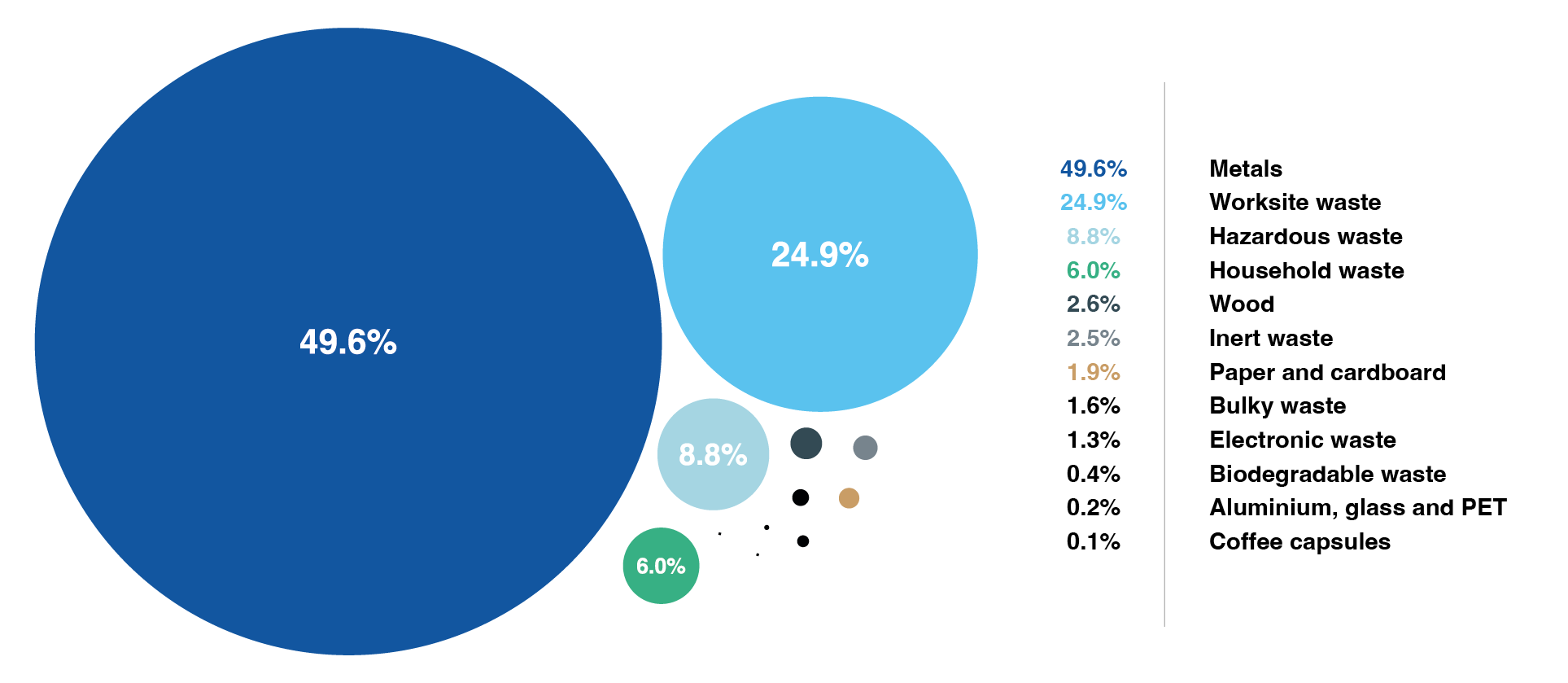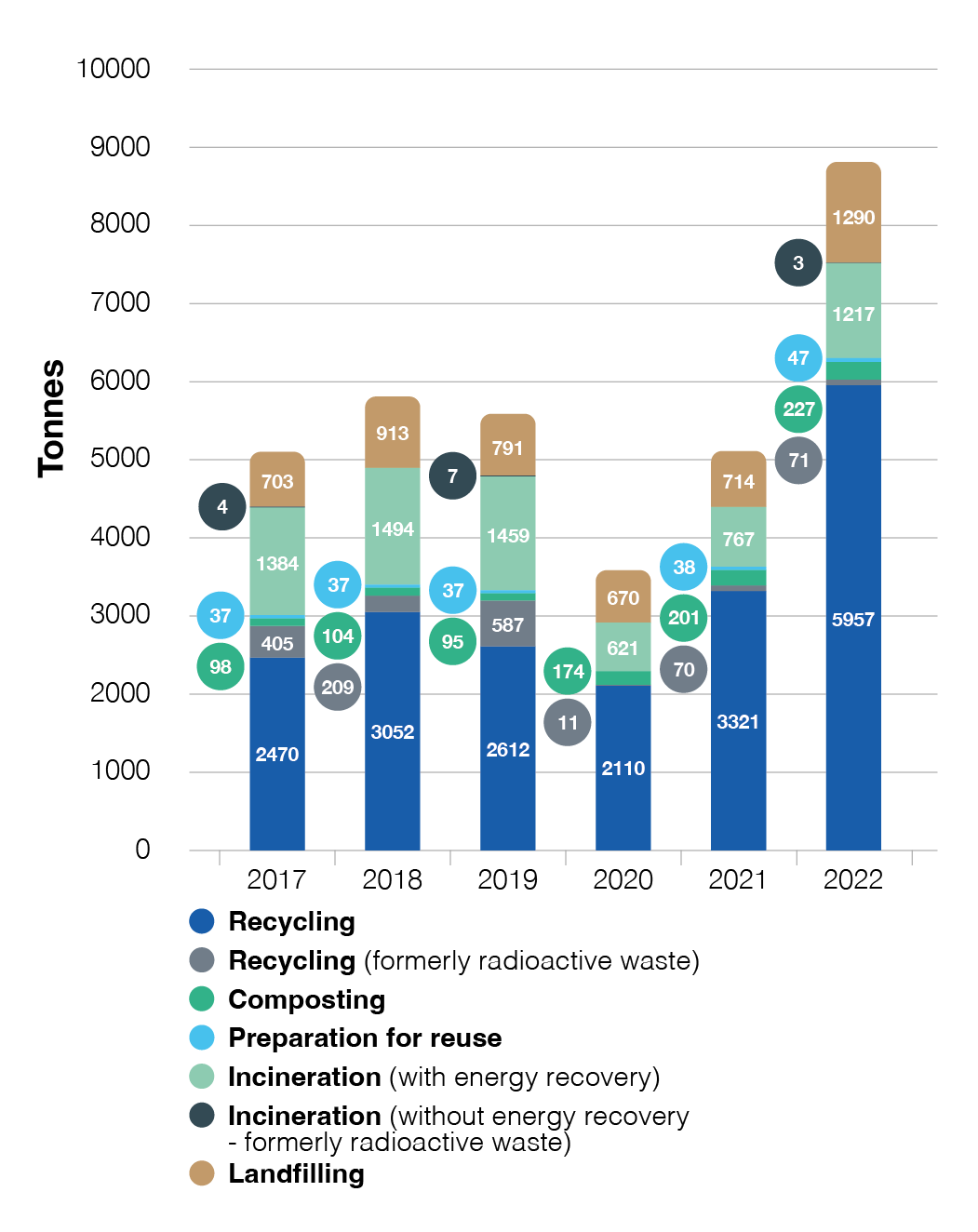CERN’s strategy aims to ensure the appropriate management of waste in a way that is safe for people and the environment.
Managing conventional waste
CERN’s scientific activities generate the majority of the Organization’s waste. The Laboratory’s conventional waste can be divided into three broad categories: campus, industrial and worksite waste. It is further categorised as either non-hazardous (metals, glass, PET, paper and cardboard, coffee capsules, biodegradable waste, household waste, and electrical and electronic equipment - the latter being subject to monitoring according to the Swiss regulation OMod), or hazardous (chemicals and their containers, batteries, printer cartridges, lightbulbs and any type of equipment and materials contaminated by hazardous substances). In 2021 and 2022, CERN disposed of 5111 tonnes and 8812 tonnes of non-hazardous waste and of 1544 and 1295 of hazardous (both conventional and radioactive) waste respectively.
CERN has a centralised waste management system that oversees all conventional waste collection and the transportation of campus and industrial waste. The system also includes an inventory of the waste leaving CERN in order to ensure the traceability of waste pathways. Hazardous waste is temporarily stored in a buffer zone, where it is collected weekly.
The Laboratory works with authorised third-party service providers to manage the disposal of conventional waste other than metals and electronic waste. The latter two are among those sorted and sold for recycling. Data on end-of-life equipment picked up by or sent back to the supplier is not included in this report. Data on worksite waste generated by contractors is also not included, as contractors manage waste disposal themselves in accordance with the relevant Host State regulations. CERN strives to constantly increase the traceability of the waste disposed of by its contractors.

Reuse and recycle

CERN’s aim over the reporting period has been to increase its recycling rate for non-hazardous waste, which represents over 70% of the total waste generated. In 2022, this recycling rate was 69%, compared to 56% in 2018. The marked increase in 2022 is due in part to the large quantity of metals that are being recycled following the second long shutdown (LS2). Furthermore, a pathway for the recuperation, reconditioning and sale of viable equipment, including furniture, IT and electronic equipment, is in place.
The pilot project involving centralised sorting bins for campus waste that was launched in 2019 has been expanded to cover more buildings and some workshops and to include the sorting of different metals. The project has made it easier for personnel to sort their waste close to their place of work. Even though the total amount of waste generated has remained the same, the recycling of paper and PET has markedly improved.
CERN’s approach to waste management follows the “reduce, reuse and recycle” principle. In this vein, the Organization aims to become an eco-exemplary campus, continuing to fully comply with the applicable French and Swiss regulations in terms of waste management and waste disposal. A dedicated waste management roadmap was published in August 2022, paving the way for additional and more refined objectives that will be covered in future reports.
Managing radioactive waste

CERN’s scientific activities produce radioactive waste, classed as hazardous waste, with low and intermediate levels of activity, which are generated by the interaction between particle beams and equipment present inside the accelerator complex and detectors. Equipment that is activated by this process, such as beam dumps (see In focus below), is managed as radioactive waste at the end of its life cycle. Radioactive waste consists, for example, of metal components, cables and ventilation filters, as well as items potentially contaminated during maintenance and upgrade work, such as gloves and overalls. In 2021 and 2022, CERN disposed of 307 and 519 tonnes of radioactive waste respectively.
The Organization minimises the amount of radioactive waste in the design, operation and decommissioning of accelerators, experiments and other equipment by avoiding, reusing or recycling activated material, such as activated shielding components. In 2021, a total of 2077 tonnes of steel, cast iron and concrete was reused. In 2022, this figure was 906 tonnes. A further 259 and 135 tonnes of processed radioactive waste was diverted from disposal in 2021 and 2022, respectively, for reuse inside CERN facilities.
CERN’s specialised radiation protection team monitors and categorises radioactive waste. It is processed in a dedicated facility where it is sorted, compressed and packaged according to the treatment and elimination criteria applicable to radioactive waste. Before being eliminated, radioactive waste is temporarily stored in a dedicated storage area.
Collaboration with Host States
Radioactive waste management has always been a high priority for CERN. It is handled in the framework of the tripartite agreement with the Host State authorities on radiation protection and radiation safety (see Management approach).
CERN’s radioactive waste is disposed of through agreed pathways in France and Switzerland. In Switzerland, CERN makes use of the possibility for clearance, whereby waste that no longer qualifies as radioactive according to the Swiss ordinance for radiation protection (ORaP) is treated as conventional waste.
NEW DECISION ON FAIR SHARE
As France and Switzerland have different approaches to radioactive waste management and elimination pathways, the tripartite agreement requires that CERN optimise its radioactive waste elimination by choosing the most appropriate solution for each category of waste. It also requires that these solutions ensure an equitable distribution between the two countries, known as the fair share principle. The implementation of the principle was revised in 2022, reflecting the experience gained and lessons learnt over the last ten years. The new decision outlines what type of waste will go to which country and through which elimination pathway. It also makes it easier to compare and measure the share between the two Host States. The share is monitored using three indicators: the volume eliminated, radiotoxicity and elimination costs. These indicators will be followed up at the annual plenary tripartite meetings with the Host State authorities.
In focus

Angelo Infantino is a nuclear engineer in CERN’s Radiation Protection group.
— The LS2 of the LHC allowed major maintenance and upgrade works to be performed in which the Radiation Protection group was involved. Can you tell us about this in the context of the LHC beam dump core autopsy?
AI: For context, a beam dump is a device designed to absorb the energy of particles once they are no longer useful for scientific research purposes. Over time, beam dumps become activated. The LHC beam dump core autopsy was a multidisciplinary project undertaken during LS2, revolving around the unprecedented action of dismantling the two LHC beam dumps at Point 6 ready for an upgrade for Run 3 of the LHC. This long and complex intervention allowed teams to gather crucial information needed for Run 3 operation and for designing future generations of beam dumps for the next upgrade of the LHC.
— What were the main challenges of this operation?
AI: The two key challenges of the project were removing the dumps from the accelerator and preparing these highly activated objects for elimination as radioactive waste.
The beam dump selected for autopsy was cut into pieces, which later allowed us to inspect the state of the inner graphite disks it contains. The dumps are also among the first items in the “intermediate and low-level radioactive waste” category, which contains nuclides with short half-lives (FMA-VC waste). This category will be subjected to new, dedicated disposal pathways that CERN is currently discussing with the French authorities. ANDRA, the operator of France’s radioactive waste repositories, visited CERN's worksite to gather knowledge and understanding of the properties of such types of waste and how it is treated.
— Why is this project important?
AI: The project was important as it combined two key aspects: an autopsy, which provided crucial information needed for the design of future beam dumps, and waste treatment. This allowed considerable savings to be made in terms of time, resources and doses. The project was highly successful, demonstrating the capability of the teams at CERN to face challenges.
Learn more
Questions regarding this report may be addressed to environment.report@cern.ch.
